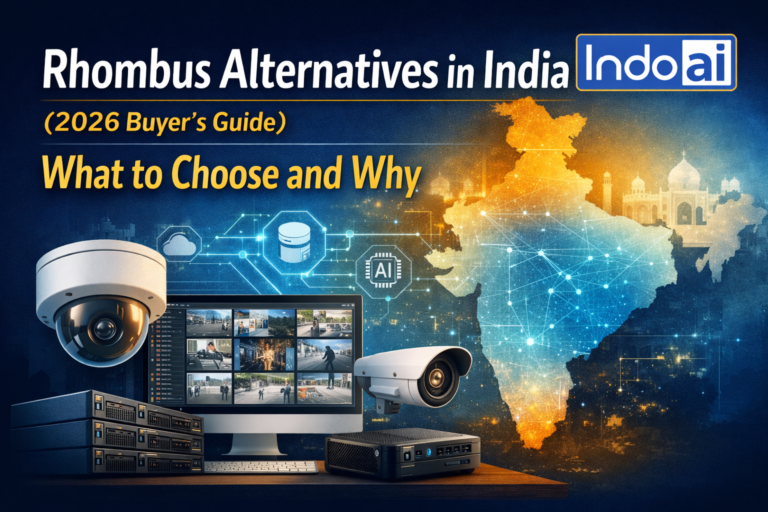
In a time of digital transformation, AI cameras have become indispensable across industries, from manufacturing plants and retail businesses to smart cities. AI cameras provide transformational visual insights into operations, safety, and security, but they also capture and process visual data that may contain sensitive personal and proprietary information.
Privacy concerns are not a choice, they are a necessity. On-device processing, or edge-AI, is a game-changer because it keeps analytics local to the camera hardware. This article discusses why on-device processing is essential to protect privacy, reviews the technical and regulatory landscape, and presents how IndoAI is defining the standard for AI cameras that are privacy-centric and secure.
The Imperative of Data Privacy
As the usage of AI cameras increases, the amount of video storage is also increasing. In many environments, the video feed includes faces, license plate numbers, employee activity, and even confidential information on whiteboards. Centralized architectures, which transmit raw footage to cloud servers, create significant attack surfaces at multiple points (in-transit-streaming, someone piggybacking into a data-center, and many more). If anything along the chain is breached (no matter your fault), the reputational damage, fines and loss-of-public-trust are all collapsing in on you.
Regulations require organizations to demonstrate a clear purpose for processing data, implement privacy-by-design frameworks, and reduce data retention. Unfortunately, for AI-camera deployments, common central cloud persistence workflows are often incapable of meeting these legal obligations without prescribed encryption, network acceptance, and auditing.

How On-Device Processing Safeguards Privacy
Analytics is integrated in-camera through on-device AI processing. Cameras process frames on-device and send only insights or alerts for decision-making, instead of streaming video. This approach provides several privacy benefits:
- Minimal Data Exposure: Since raw footage rarely leaves the device, the attack surface for intercepting sensitive information is drastically reduced.
- Immediate Filtering: Frames containing no actionable events can be discarded instantly, preventing unnecessary retention of personal data.
- Local Encryption: Critical metadata—such as event logs, snapshots, or alert packets—can be encrypted and stored on-device, ensuring that even if hardware is compromised, data remains protected.
- Configurable Retention Policies: Administrators can set precise rules for how long event clips persist on the device, aligning with privacy-policy requirements and reducing liability.
This transparency builds stakeholder confidence and streamlines compliance audits.
Technical Foundations of Secure Edge AI
Implementing robust on-device AI requires a harmonized blend of hardware, software, and networking features:
- Trusted Execution Environments (TEEs): Specific parts of the SoC use secure enclaves to isolate important operations, like decryption keys and model weights, from the main OS. TEEs bar unauthorized access even if the device firmware has already been compromised.
- Lightweight AI Models: Inference engines focusing on privacy depend on optimized neural networks that may run on low compute capacities. Quantization, pruning, and depthwise separable convolutions meet the efficiency of execution without a significant loss of accuracy.
- Secure Boot and Firmware Signing: Every software component—from bootloaders to AI modules—must be digitally signed. Secure-boot sequences verify signatures before execution, preventing installation of unauthorized code that could exfiltrate data.
- Encrypted Storage and Transmission: On-device flash storage employs AES-256 encryption to protect logs and event clips at rest. When data needs to cross the network—like alert packets being sent to a central dashboard—TLS channels provide end-to-end confidentiality.
- Role-Based Access Control (RBAC): Even in an organization, it would not be appropriate for all users to have access to raw footage or AI metadata. RBAC mechanisms are implemented with granular permissions to ensure that only approved roles can configure, see, or archive event data.
Regulatory Alignment and Auditability
Organizations deploying AI cameras must navigate a complex web of global and local data-protection laws. On-device processing simplifies compliance in several ways:
- Data Minimization: By default, only minimal information leaves the camera. This principle is central to GDPR and similar frameworks.
- Consent Management: In public-facing environments, cameras can anonymize or blur faces unless an alert triggers retention. On-device motion detection can flag events without capturing personally identifiable details.
- Audit Trails: Edge-AI systems log all inference requests, model updates, and administrative actions locally. These tamper-evident logs provide clear records for regulators.
- Data Sovereignty: For regions requiring data to remain within national borders, on-device analytics eliminate the need to transmit raw video across jurisdictions.
The Business Case for Privacy-First AI Cameras

Privacy concerns are not only regulatory; they influence customer trust, brand reputation, and even employee morale. Consider these scenarios:
- A retail chain utilizes AI cameras for monitoring checkout lines but wants to avoid causing an issue with customers regarding facial recognition. On-device inference, which counts people without saving images, supports operational and ethical aims.
- A pharmaceutical manufacturer implements AI cameras for process monitoring. Intellectual property on batch formulations must remain confidential, and raw footage never leaves the plant network.
- A corporate campus uses cameras for parking-lot analytics. Vehicle-license-plate scanning takes place locally, and only anonymized usage metrics are shared with management.
In each case, privacy-centric designs enable powerful AI functionality without compromising stakeholder confidence. The result is accelerated adoption, smoother rollouts, and a stronger competitive edge.
How IndoAI Excels in Privacy-Centric Edge AI
IndoAI has emerged as a leader in privacy-first AI camera solutions. From the ground up, their platforms integrate the security and compliance features enterprises demand:
- Built-in TEEs and Secure Boot: IndoAI cameras leverage hardware-rooted security to safeguard model integrity and data confidentiality.
- Appization Framework: Our containerized AI-model architecture isolates applications to prevent cross-model data leakage. Enterprises can add or remove analytics apps without risking unauthorized data sharing.
- Adaptive Data Policies: Through a unified dashboard, administrators customize retention and transmission settings per camera or location, ensuring that privacy requirements are met across diverse use cases.
- Zero-Trust Network Integration: IndoAI’s devices support microsegmentation, limiting lateral network movement and ensuring that cameras can never be used as a stepping-stone for broader attacks.
- Transparent Compliance Documentation: IndoAI provides detailed whitepapers, third-party security assessments, and deployment guides aligned with GDPR, India’s data-protection framework, and other standards.
Best Practices for Privacy-First Deployments
To maximize the benefits of on-device processing, organizations should:
- Perform Privacy Impact Assessments (PIA) early on by identifying data flows, stakeholder concerns, and existing regulations.
- Establish clear data-retention policies which are linked to the business context and legal considerations.
- Consistently update AI models, firmware, etc., with signed patches to ensure security vulnerabilities are remediated.
- Train your operations and IT teams in privacy-by-design and secure-configuration baselines.
- Continuously monitor system logs and alerts for unauthorized access attempts and abnormal inferences.
Conclusion
As AI cameras begin to appear in nearly every industrial, and public sector, it is paramount to emphasize data privacy. On-device processing offers a compelling alternative as it retains sensitive footage locally. It minimizes data exposure,and facilitates compliance with diverse regulatory requirements worldwide. Bad actors can threaten the data privacy of companies and individual employees, while also allowing for additional public and/or private surveillance to occur earlier in the VMS decision-making process.
IndoAI’s on-device processing (edge-AI) platforms are also designed with privacy considerations. On-device AI allows organizations to attain the value of intelligent video analytics.



